Just say “Enhance!” to bring your alarms into crystal-clear focus
June 29, 2020 /
0 comments / in
General
/ by Richard Stember
Okay, maybe that only works for Jack Bauer. But, just like Jack, the new Enhanced Alarm Configuration (EAC) feature can help you avert catastrophe.
It seems like only yesterday when I presented at WESC our CygNet 9.4 ambitions for the Enhanced Alarm Configuration feature set to an enthusiastic audience. Since then, CygNet 9.4 released in February and I have enjoyed assisting many of you with your initial explorations and deployments of the new EAC capabilities. A result of that effort was the creation of a simple demonstration system to help bring some of the EAC concepts to life. This demonstration system, on which this post is based, includes the following Water Tank Station screen (built using High Performance HMI techniques, of course). The point values in this demonstration system are generated by a handy-dandy simulator and are updated every second.
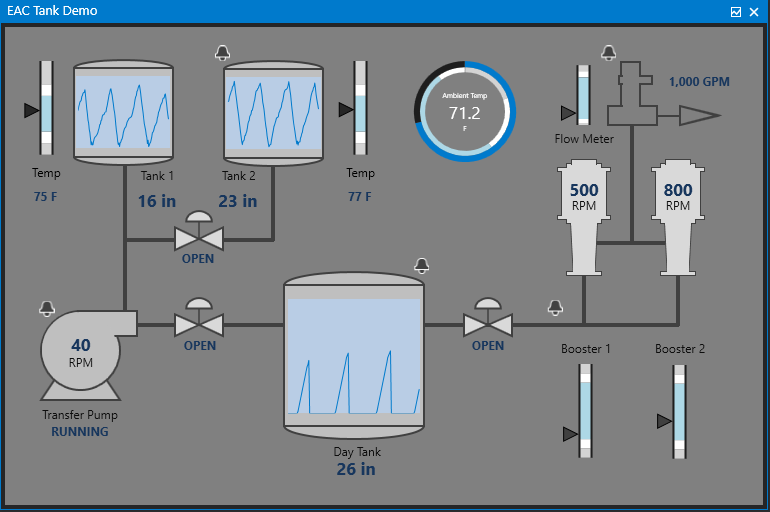
The operations represented by this screen are straight forward.
- Water from an industrial process fills Tank 1 and Tank 2.
- When either tank is nearly full, the transfer pump starts and empties both tanks into the larger Day Tank, passing through 2 shutoff valves along the way.
- When the Day Tank fills sufficiently, one or both Booster Pumps empty the Day Tank.
- The water is delivered to a pipeline through the Flow Meter.
Simple enough, eh? But even this process provides many opportunities to apply useful EAC conditions due to the interdependency of the equipment involved. Potential applications of EAC conditions are indicated on the screen with this bell  image.
image.
For example:
- If Valve 1 leading from Tank 2 is closed but the tank is still losing water, we could generate a “Potential Leak” alarm.
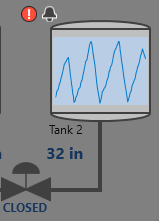
- If the Transfer Pump is running but the outlet Valve 2 is closed, we could generate a “Pump Blocked” alarm.
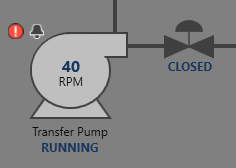
- If Valve 3 feeding the booster pumps is closed but the pumps are still running, we could generate a “Pump Run Error” alarm.
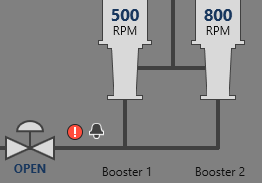
- If the booster pumps are running but the flow meter is not measuring any flow, we could generate a “Potential Air Gap” alarm. Unless, of course, that pesky closed-valve situation of example 3 exists but we can check for that as well.
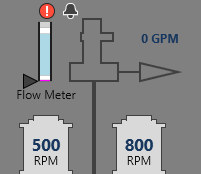
Let’s take a deep dive on example #1, the generation of a “Potential Leak” alarm for Tank 2. The following are the EAC settings for the Tank Level point for Tank 2.
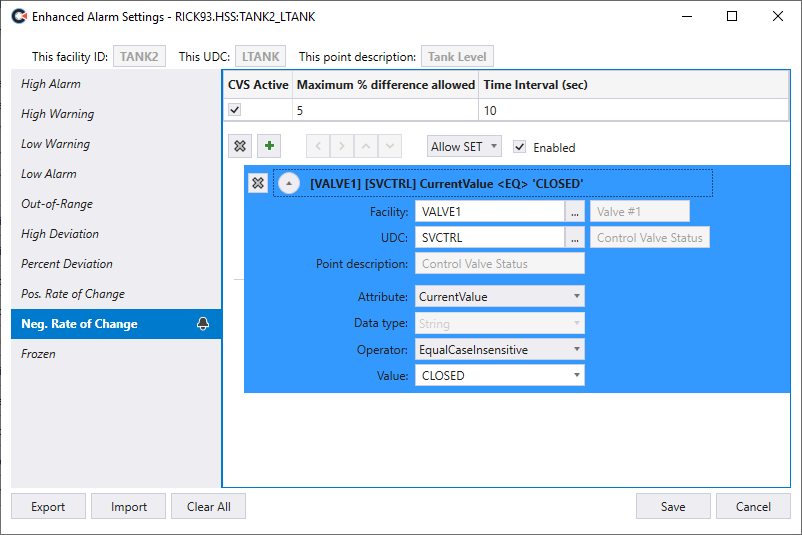
As you can see, the Tank Level point has a “Negative Rate of Change” status bit configured to trigger if the water level of the tank drops more than 5% over a 10 second period. “Hold the phone!”, you exclaim. “That Transfer Pump regularly drains that tank at a much higher rate than 5% over 10 seconds. That “Negative Rate of Change” alarm would be triggering every time that pump runs, right?” And you would be correct. However, that’s where the magic of EAC conditions comes in.
As the above dialog shows, the EAC condition associated with the “Negative Rate of Change” status bit contains a single expression. That expression is evaluated within the CVS (UIS, HSS, etc.) every time it determines that a status bit should be set but before it actually is set. If “Allow SET” is configured for the condition and the expressions evaluate to True, the status bit is set. If “Prevent SET” is configured for the condition and the expressions evaluate to True, then the status bit is not set (or cleared if already set [props to Alex Lindsay]).

In this case, the expression mandates that, to allow the status bit to be set and a “Negative Rate of Change” alarm generated, the current value of a different point, the “Control Valve Status” of Valve 1, must indicate that the valve is “CLOSED”. Conversely, if the valve is not in the “CLOSED” state, then the setting of the “Negative Rate of Change” status bit is skipped, and the associated alarm is not generated.
Below is this EAC setting in action. The “Negative Rate of Change” status bit has been set and the associated “Potential Leak” alarm has been generated because Valve 1 is “CLOSED” but the level in the tank is still falling.
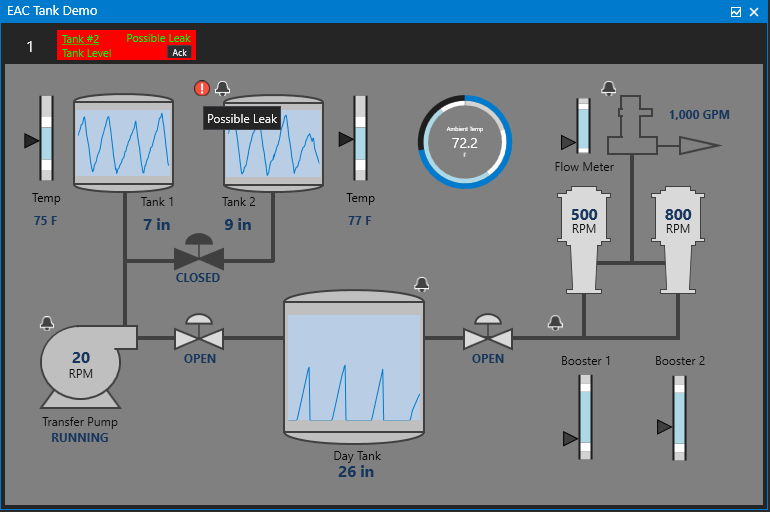
Let’s take this example a bit further by pretending to observe that when Valve 1 closes, back-pressure is generated in the water column flowing out of Tank 2. As this pressure wave settles out, the tank level reading fluctuates up and down for a period of time (technical term, “sloshing”). Also pretend to observe that this sloshing results in a false positive “Negative Rate of Change” determination. To prevent this false positive, the following additional expression can be added to the EAC condition.
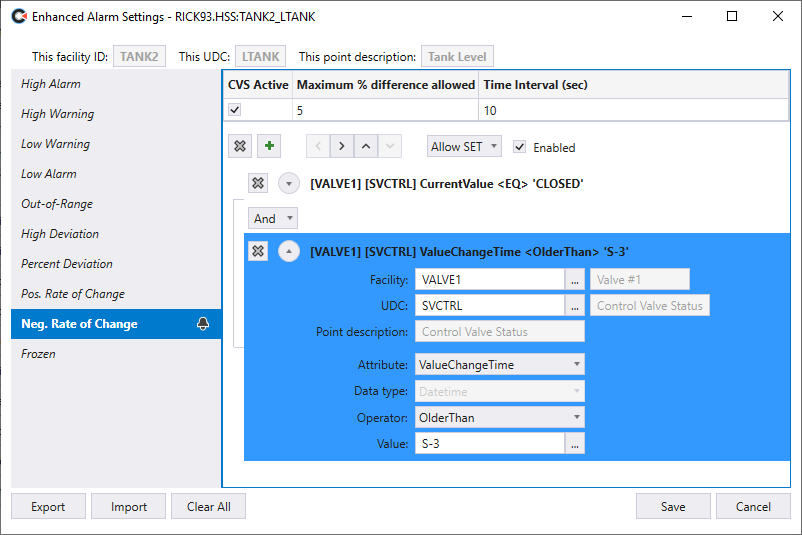
This new expression uses the ValueChangeTime attribute for the “Control Valve Status” point of Valve 1. The ValueChangeTime attribute of the point is defined as the instant in time when the current value of the point was first set. Even though the point may have been updated several times with same value which would have changed its timestamp, ValueChangeTime will return the timestamp associated with the originating value change.
The Value field of the expression can be expressed as a specific timestamp or, more usefully, in the standard CygNet relative time format (see CygNet Help). In this example, the expression Operator is set to OlderThan and the Value is set to “S-3”. This expression combined with the previous expression with the And joining operator has the effect of allowing the “Negative Rate of Change” status bit to be set only if Valve 1 is “CLOSED” and has been in the “CLOSED” state for more than 3 seconds. This 3 second delay, in theory, will allow for the tank contents to settle before assessing if the tank level is falling at an alarming rate.
Up to 20 individual expressions are supported per condition and so many more equipment interactions can be considered. For example, shouldn’t we signal a “Potential Leak” if Valve 2 is “CLOSED” but the level of Tank 2 is still dropping? Probably, and the following expressions should get that job done.
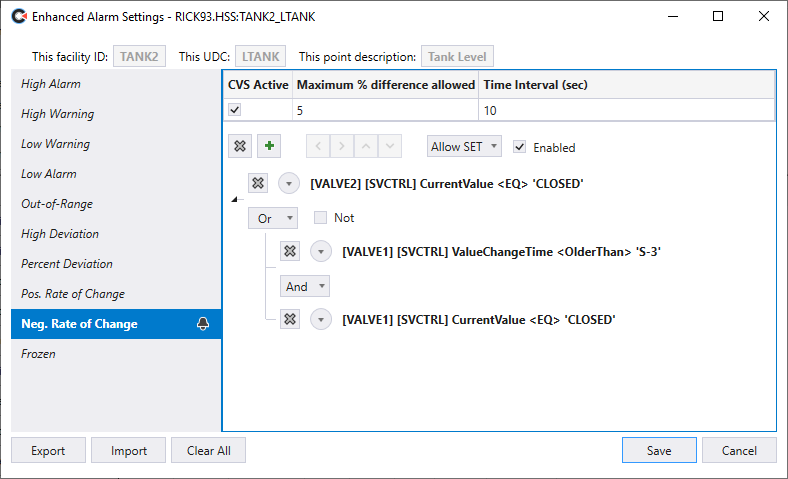
I hope this has given you a sense of how the Enhanced Alarm Configuration capabilities might be applied to your CygNet deployments.
Share this entry













